 |
| December 16, 2014 | Volume 10 Issue 47 |
Designfax weekly eMagazine
Archives
Partners
Manufacturing Center
Product Spotlight
Modern Applications News
Metalworking Ideas For
Today's Job Shops
Tooling and Production
Strategies for large
metalworking plants
Wings:
Making production-grade, flight-certified hardware with industrial 3D printing
Bell Helicopter and Harvest Technologies utilize design-driven manufacturing with EOS plastic laser-sintering technology.
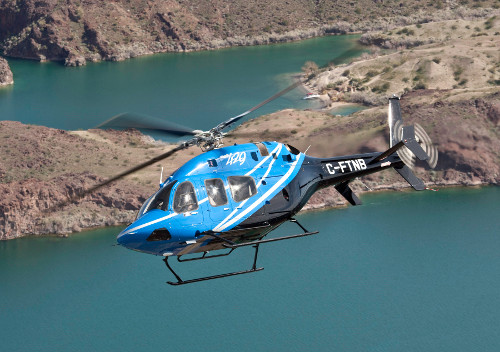
The Bell 429: Parts of the Environmental Control System (ECS) of this commercial helicopter were produced by using EOS laser-sintering technology [Courtesy Bell Helicopter Textron Inc.]
Sometimes, a company's entire manufacturing history begins with prototyping.
In 1941, Arthur M. Young demonstrated an ingeniously engineered model helicopter flying on a tether while working for Bell Aircraft Corporation. Just five years later, the company received the first-ever certification for a commercial helicopter. Today, Bell Helicopter Textron Inc. (headquartered in Fort Worth, Texas) has made and sold more than 35,000 helicopters worldwide.
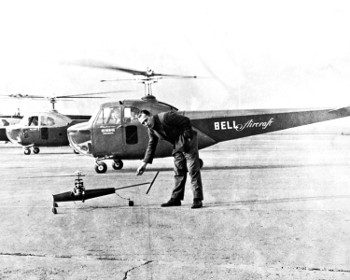
From concept to reality, Arthur Young poses with his final research model, alongside the commercially certified Bell Model 47B. [Circa 1947; courtesy Bell Helicopter Textron Inc.]
Bell Helicopter supplier Harvest Technologies began as a one-machine start-up in Texas and has grown to be a world leader in 3D printing/additive manufacturing (AM). Today, Harvest has a 40,000-sq-ft facility in Belton, Texas. The company has over 40 AM systems, many of them used to create end-use components and assemblies.
"We've worked with Bell Helicopter right from the time they decided to explore the use of additive manufacturing beyond prototyping to the actual manufacture of flight-certified hardware," says Caleb Ferrell, Quality Manager at Harvest Technologies, "and they've been a key partner for us as we expand through the aerospace industry."
The work that Harvest and Bell Helicopter do together is a textbook case in how AM can be a high-quality, repeatable, cost-effective manufacturing methodology -- in this instance, with plastic laser-sintering from EOS.
The path to production for Harvest, Bell Helicopter, and the P 730 laser-sintering system
Bell Helicopter was certainly no stranger to laser sintering when they began to evaluate the process as a viable option for end-use part manufacturing. For years, Bell Helicopter and Harvest have partnered together to produce flight-certified hardware on a standard laser-sintering platform. Bell Helicopter felt they could achieve success with laser sintering because of their extensive experience qualifying both products and manufacturing processes, and Harvest had the expertise in AM that they were looking for.
When Harvest purchased an EOSINT P 730 plastic laser-sintering system in 2011, their existing AM production capabilities rose to a new level. Their EOS system features twin 50-watt lasers working in tandem over an expansive build area -- a first for laser-sintering technology -- to achieve a layer-by-layer build speed of 35 mm/1.38 in. per hour of height.
With this new addition to their fleet, Harvest reached out to Bell Helicopter. This platform had several advantages they felt Bell Helicopter would be interested in, and Bell Helicopter's culture of innovation, cooperation, and agility made them the perfect partner to qualify this machine for end-use part production of their hardware.
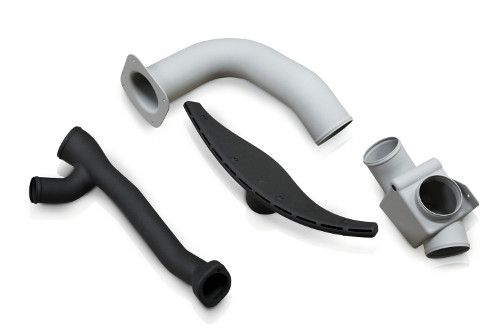
Plastic laser sintering is capable of creating complex shapes such as the ductwork above. [Courtesy Harvest Technologies]
"The parts that we get from the P 730 have very good feature definition, and the powder color has consistently exhibited less oxidation," Ferrell says. "Other mechanical properties have been good as well. We're especially happy with the larger platform size and the nestability we've been able to achieve."
These last two attributes contribute to reducing the per-unit cost. The build platform is 700 mm (27.6 in.) by 380 mm (15 in.) by 580 mm (23 in.), much more spacious than the standard laser-sintering systems Harvest used. The increased build platform size means the system can produce more components in a batch -- and, with judicious nesting practices, far more than most other laser-sintering platforms. "We use software to guide nesting," Ferrell says, "but we also have some very talented people on staff, and with their expertise we achieve even better results, including more cost-effective, low-volume production."
How cost effective? "Bell Helicopter and Harvest have done a number of conversions of aircraft parts from previous processes to laser sintering," says Elliott Schulte, Engineer III at Bell Helicopter. "The preconception has been that using additive manufacturing would be more costly compared to alternate manufacturing methods with design flexibility being the premium, but with the P 730 we often discover that the production cost per piece is substantially reduced." (See sidebar, "The 'why' of making aircraft parts on the EOSINT P 730.")
Challenge
Selection of the EOSINT P 730 for manufacturing aircraft parts was a deliberate choice for Bell Helicopter and Harvest. It came about as a result of careful study and testing, focusing on intertwined technical and financial benefits that made business sense.
However, before production could begin, Bell Helicopter and Harvest needed to prove out the EOSINT P 730 and its processing capabilities in order to certify the platform for use. The new technological advances EOS implemented in the system and sheer platform size would certainly provide greater efficiencies, but Bell Helicopter and Harvest needed to ensure this was not at the cost of part integrity.
The dual laser system and the subsequent "knit line" presented a new consideration both companies needed to analyze and evaluate. Verifying a new platform meant not only addressing these factors, but also examining other common issues such as heat distribution (part bed temperature consistency), powder degradation, dimensional accuracy, repeatability, part quality, part performance, and the overall economics of the platform.
Solution
First, Bell Helicopter characterized the materials themselves -- a variety of laser-sinterable Nylon 11s and 12s. "We have Bell Helicopter-authored specifications both for the materials and the manufacturing method," Schulte says. Once that step was completed, the existing materials characterization and database ensured that the P 730 machine qualification (both the system and its process) was accomplished quickly.
"We characterized the mechanical properties of each laser-sintered build," Schulte says, "so that we could confirm that the EOS system met our specification requirements and produced the same quality product each time." This systematic testing was done with a number of different materials lots and a series of individual builds to establish that laser sintering was robust and highly repeatable with identical results.
Bell Helicopter also followed their standardized procedure for auditing suppliers, not just for conformation of the Bell Helicopter process specification, but also a quality audit, periodically reviewing Harvest's QA system with an eye to AS 9100C, the SAE quality management standard for aerospace.
With both the P 730 system and nylon materials qualified, Bell Helicopter and Harvest could begin the meticulous sequence of manufacturing aerospace hardware, which involves many checks and confirmations along the way.
How parts are produced
As a hypothetical example, suppose Bell Helicopter wanted to incorporate a new piece of ductwork into the Environmental Control System (ECS) of a commercial helicopter.
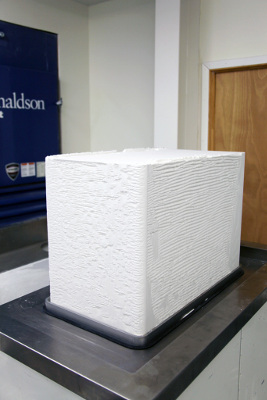
After laser sintering is done, the completed parts require "breaking out" from the powder. [Courtesy Harvest Technologies]
First, the engineering team would call up the same database used to qualify the P 730. Based on the mechanical properties specified, engineers would then design a duct. It might differ from an earlier design by merging several components into one (part consolidation), or by taking its form exclusively for maximum functionality, rather than manufacturing demands (such as draft angle for molding, wall thickness limitations due to material input, or rounded corners for CNC machining). Regardless, the hardware must meet the same final performance specifications.
Again, that doesn't mean the redesigned part would necessarily have the same shape or features. "Material characterization is a critical consideration for us during design," says Christopher Gravelle, Bell Helicopter's Rapid Prototyping Lab lead. "For instance, if you're creating bosses for attachment points in laser-sintered nylon, it's a new material and process -- you can't just use the exact configuration you would for a metal part." The engineers at Bell Helicopter treated many designs as "a mostly clean slate," Gravelle says. "Laser sintering gives us a great deal of flexibility and freedom."
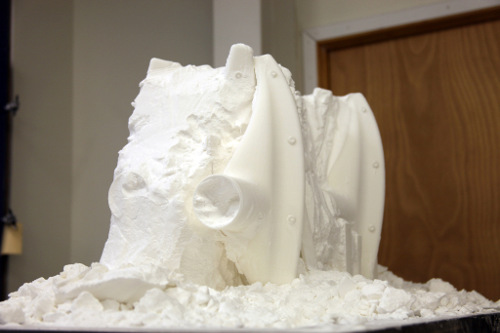
Excess powder is then removed and much of it re-used for subsequent builds. [Courtesy Harvest Technologies]
After a final review of the design for system producibility, Bell Helicopter would send a 3D CAD model along with a request for quote (RFQ) to Harvest for review and for development of a build strategy. Is the part large enough that it should be manufactured on its side, speeding up the build? Should it be made (or "grown") standing vertically, to take advantage of tighter uniformity and accuracy on the x-y axis? How nestable is it, and how many units can be made in a single build? After determining these and other considerations, Harvest would be able to submit an accurate pricing quotation.
Once Bell Helicopter accepted the quote, production would begin in earnest at Harvest. Before each batch, there is a rigorous checklist of pre-production inspections developed by Harvest -- for instance, a nitrogen leak rate check -- that reduces waste and ensures part quality. The list was developed specifically for the P 730 based on previous production runs, even though Harvest found that the EOS system was more robust and reliable than the other laser-sintering technologies they have in their fleet.
The batches of laser-sintered parts would be built successively, often unattended overnight, but post-production examination is as thoroughly hands-on as the pre-production checklist. "After every build, we test for tensile and flexural properties," says Ferrell. This is a requirement established for process assurance that Harvest continuously monitors. The test involves incorporating production of tensile bars along the x, y, and z axes of each batch. The completed bars are subjected to an Ultimate Tensile Strength (UTS) test. If they pass, then the parts built in that batch pass as well. This is by no means the only completion requirement: In addition to the part itself, one of the most important products at Harvest is the documentation of manufacturing from beginning to end, including mechanical integrity, unique serial IDs for each part, and material certification.
Before submitting the completed batch, Harvest would send a pre-production sample to Bell Helicopter -- as required, where it would be examined to make sure that it is functional, that it fits accurately with other components, the engineering specifications have been met, and that Harvest's inspection procedure is both correct and completed.
"We have full confidence in Harvest and their quality assurance program," Schulte says. "Once their QA is complete, when warranted, we go to some lengths ourselves to make sure that the design intent is also met. We continue to work with Harvest to streamline production and take advantage of additive manufacturing technology maturation." Only when this final scrutiny is complete does Harvest ship the rest of the production batch to Bell Helicopter's receiving department to fulfill the order.
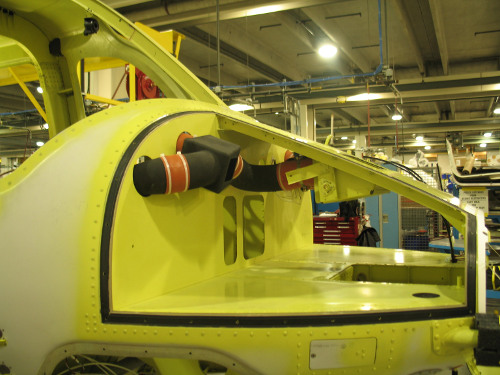
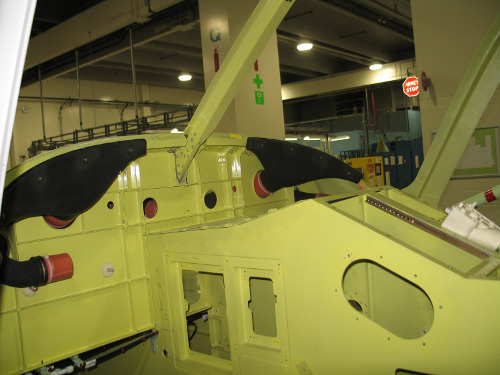
Two views of laser-sintered ductwork installed in a helicopter airframe. [Courtesy Bell Helicopter Textron Inc.]
Freedom to manufacture innovative designs
New versions of this story are happening daily, as engineers from Bell Helicopter propose innovative designs and engineers and technicians from Harvest turn Bell Helicopter's CAD models into physical reality. And AM production is expanding: Bell Helicopter is interested in employing laser-sintered parts throughout the aircraft systems of their commercial helicopters.
At present, the company is mostly using laser-sintered components in the ECS system. "Now the ECS engineers who've gained experience with the material and the process are communicating to teams with other functions, and those teams are starting to incorporate laser-sintered hardware into their assemblies," Schulte says. Bell Helicopter will also be evaluating laser sintering of high-temperature plastics intended for use in more demanding roles and environments.
AM is transforming more than the designs at Bell Helicopter. Engineers are now learning to take greater advantage of the freedom that comes with applying EOS technology. "Our engineers are still creating small components, but they're becoming comfortable working with larger ones than in the past," Gravelle says. "They're also using the part-integrating capability of laser sintering to eliminate assembly costs."
With regard to Harvest, Ferrell adds, "In addition to the design advantages, there are significant manufacturing benefits to plastic laser sintering. Tool-less manufacturing means you don't face certain limitations and upfront costs. And if you need to change something, you can build new revisions simply by changing the CAD file -- no molds, no new machining tool paths, and very little wasted time or money."
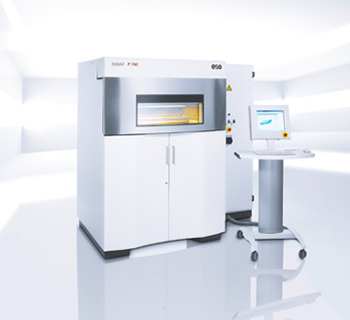
EOSINT P 760. [Source: EOS]
Harvest has acquired a second P 730 system and an EOSINT P 760 system from EOS, and is currently working with Bell Helicopter to implement the manufacture of one-off or two-off orders of spares, nested in with their existing batch production. "We have a strong legacy of using 3D-printed thermoplastic parts," Schulte says. "We definitely want to stay at the forefront of new laser-sintered materials and processes, so we'll continue our IRAD [Independent Research and Development], supply chain integration, and our industry involvement with additive manufacturing."
Sidebar: The "why" of making aircraft parts on the EOSINT P 730
Selection of the EOSINT P 730 for manufacturing aircraft parts was a deliberate choice for Bell Helicopter and Harvest. It came about as a result of careful study and testing, focusing on intertwined technical and financial benefits that made good business sense.
In addition to increased nestability, the larger EOS build platform provided a number of benefits. "We could build bigger components in one piece rather than in sections," says Lewis Simms, Marketing Director at Harvest. This made for a better, stronger, more lightweight part, and it also eliminated previously necessary assembly operations.
Another advantage of the EOS system for Harvest was the clean surface it produces. Some competing AM technologies produce satisfactory parts, but collateral heat from the laser beam melts adjacent powder, resulting in unwanted particle adhesion and the need for additional post-processing to polish the surfaces smooth.
"We were able to achieve the desired quality with the other additive system," says Ron Clemons, director of business development at Harvest, "but there was a lot more finishing labor associated with it than on the EOS platform." The P 730 incorporated a software "fix" for laser sintering that provided crisper detail and smoother surfaces. As a result, there was less peripheral powder melting and adhesion. Switching to the EOS system offered significant post-processing cost savings -- and shorter lead times for Bell Helicopter.
An important secondary benefit of EOS' laser-sintering technology was increased recyclability of the plastic powder. With other AM processes, breaking out the part from the bed of powder left behind a significant amount of partially melted powder that was unusable and had to be discarded. The bulk of production was performed with new "virgin" powder. The reduction of this waste in the P 730 made much of the leftover powder more recyclable.
The success of the Harvest/Bell Helicopter collaboration with using the P 730 was twofold: Harvest brought a deep knowledge of laser-sintering manufacturing of aircraft hardware, and Bell Helicopter, among other things, brought a progressive engineering culture. "Bell Helicopter truly is much more agile at bringing in new technology, evaluating it quickly, and implementing it more efficiently than many of their competitors," Clemons says. "Their willingness to utilize our expertise, evolve their specifications, and educate and involve their technical community made them extremely rapid adaptors for a company their size."
Learn more about EOS machines at www.eos.info/en.
Published December 2014
Rate this article
View our terms of use and privacy policy
